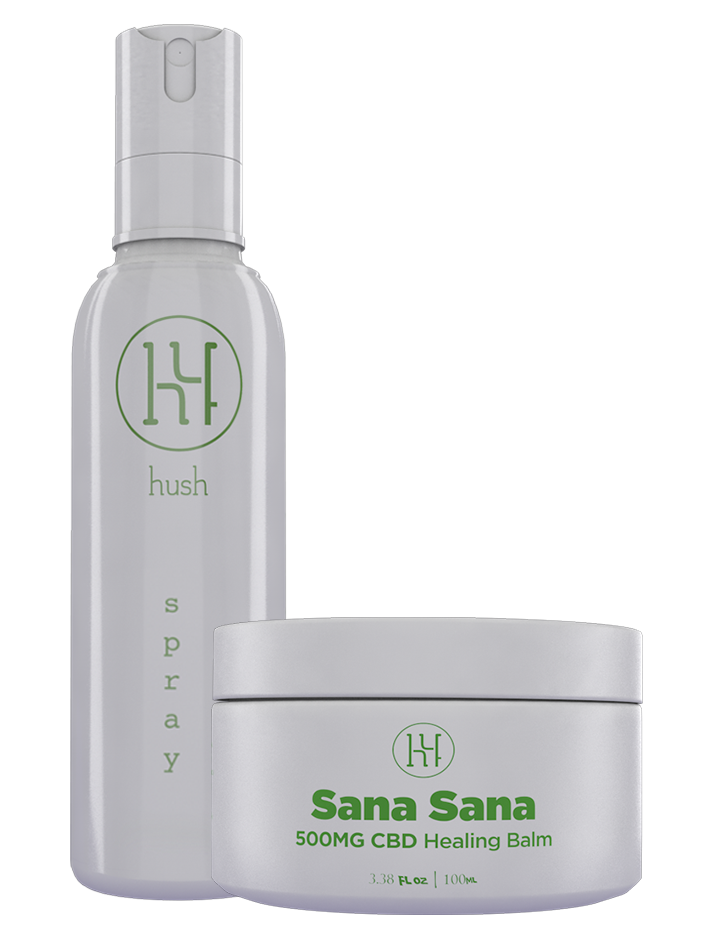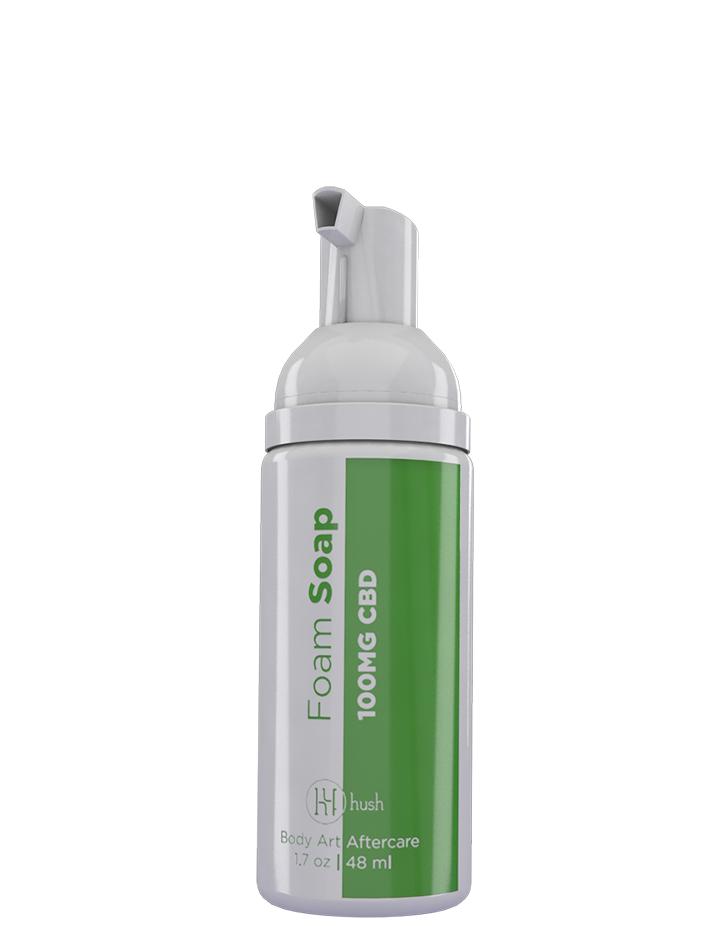
$45.99
Here’s a tattoo haiku for you:
new tattoo, a wound
itches as it heals—reveals
living art when healed
If that was too subjective for you: When your tattoo artist gives you a new tattoo, you are actually creating a dermal wound. If you couldn’t tell by the pain and millions of needle pokes, you are damaging a few layers of skin. That’s gotta heal!
If you have ever been wounded before, you’re probably familiar with that itchy sensation that happens when your wound starts healing. Usually marked by an uptick in your mood because that means the injury is getting better. But why? Why would a positive thing be marked with a terrible itch that you cannot scratch?
Let’s talk about why tattoos itch and how you can get some relief with HUSH.
Phases of Wound Healing
Let’s dive into the science of it all. If you know what’s happening on a cellular level, you will better understand what’s happening up top and why your hand is inching closer and closer to a nicely healing wound, looking to create some chaos. Keep it away! Don’t let it destroy the process!
Inflammatory Phase
The inflammatory phase of wound healing is the first phase and it starts right away. From the first tattoo needle poke you receive, wounding your skin, the inflammatory phase springs to action. More and more pokes happen and your brain starts signaling an SOS to your immune system.
The immune system swoops in, conducting your body to start flushing the wounded area with blood and lymphatic fluid. Those two together slow the blood flow and start forming blood clots at the site of the wound.
All over, there are cells as diverse as a city, working in tandem to stop blood loss, ward off bad bacteria, regenerate cells, replace broken chains of tissue, and heal your wound. On the surface it just looks red and bloody, but close up, there’s a ton of bodily magic taking place. Thanks, biology!
At this point, the itch isn’t there yet. What you are seeing is red — red irritation and heat. There is a lot of action taking place so it’s generating some energy.
Proliferative Phase
While the inflammatory phase is taking place, so is the proliferative phase in the background.
Proliferative means rapid growth in the form of new cells. Your body begins (and does not stop) rapidly growing new collagen and connective tissues, forming the core of the wound and stabilizing it.
As the inflammatory phase winds down, you are going to feel the proliferative phase more. You know what we mean? We’re talking about the itch. Yeah, here’s where that comes from.
A thin, superficial layer of outer layer skin starts forming from the edges of the wound and moving inwards. A thicker layer of cells and skin will form in time. Blood vessels generate in areas where they were destroyed. The wound gets smaller as deposits of collagen and other connective tissues continue growing.
Tons of stuff happening — things dying, things growing, things intertwining! Imagine a city. There are cars, buses, people walking, people sitting and chatting, phone lines buzzing, construction happening, lights changing, animals animal-ing.
If you were to hover over that city you would hear the harmonious buzz of the city, right? The thing singers sing about. The same thing is going on with your healing tattoo but instead of a harmonious buzz, it’s a bitch of an itch.
Maturation Phase
The last phase in wound healing is the maturation or remodeling phase. This phase first starts around three weeks and can continue for up to a year.
During the maturation phase, the formation of excess skin and cells is sloughed off, collagen is replaced with a stronger form of collagen, the wound continues to shrink, and blood flow is reduced.
Slowing the roll. Typically the maturation phase for tattoos lasts up to three to four months. This phase is like when a painter’s newest masterpiece is nearly finished but something is amiss. So they keep it in their studio and add a touch here or there every day or so until, voila! One day it’s done! Nothing left to add. Fin!
This phase is way less itchy as the number of things happening to your wound has slowed and the tattooed area is becoming more and more like your regular skin (only much cooler). Though, there are still some things still happening, so you may get a ping here or there.
How To Relieve Your Itch
You get it now. You understand the itch and why it’s a sign of incredible things happening. Now how do you get rid of it? There are a few methods to tame the itchy madness.
Moisturize
Use a healing moisturizer. Sometimes the itching is caused by your wound being too dried out. You should be moisturizing at least daily but sometimes your tattooed area will need a little extra TLC.
Add a thin layer of moisturizer and see if that aids your itchiness. Our Sana Sana CBD Healing Balm is specially formulated to soothe tattoo wounds and provide relief from irritation.
Wash
Sometimes scabby skin can be at the root of your itchiness. If your healing tattoo is in the scabbing, peeling, and flaking stage, it may need some help getting rid of that old skin.
Gently wash your tattooed area with some of our CBD Foam Soap. The CBD helps to calm inflammation and irritation and the botanicals will cleanse and soothe.
Don’t get carried away and start scrubbing though. Make sure you aren’t removing skin or scabs that are still working their healing magic on that wound. They’re helping your healing process, so leave it alone. Gentle, mindful washing only.
Anesthetic
If it’s seriously itching and nothing else is working you can use a light anesthetic.
Our Numbing Spray is supercharged with lidocaine for those itchy moments that you just can’t hack. For a double down, use our Tattoo Numbing Gel which also has lidocaine and a handful of amazing soothing botanicals. Lidocaine is a topical nerve-numbing agent that will only numb the targeted skin you spray or rub the gel on.
Both products also have soothing botanicals that are going to help reduce that itchiness and moisturize your skin while doing so.
Avoid
If you want to avoid the itch there are a few things you should avoid.
Wound Dressings
After removing that initial wrap your artist put on, don’t rebandage. If you improperly rebandage your tattoo, you could potentially lock in bad bacteria or suffocate your tattoo. A suffocated tattoo is going to itch for sure and in a bad way.
The best way to protect your tattoo is with a thin layer of a tattoo healing balm and being proactive about keeping your tattoo out of dirty situations.
What if you need to wear clothing over your tattoo wound or are getting into a situation where you’d rather have your tattoo protected with a bandage? Use a sterilized bandage that is breathable, like a Tegaderm. And remove that bandage as soon as you can.
Irritating Products
Avoid using lotions, sprays, gels, soaps, or whatever that have any of the following ingredients. They could irritate your wound and cause issues in your healing process.
- Synthetic fragrances
- Heavy chemicals
- Rubbing alcohol
- Petroleum products
Medications
The following are drugs that can negatively affect your tattoo’s healing process. They reduce the amount of new skin that is deposited to heal your wound and slow down healing time.
We’d recommend chatting with a doctor if you are taking any of these and want to get a tattoo:
- Anticonvulsants
- Steroids
- Antibiotics
- Angiogenesis inhibitors
- NSAIDs (Aspirin & Ibuprofen)
Itchy After Healing?
Are you experiencing an itchy tattoo after your tattoo has fully healed? Sometimes you may feel a one-off itch on your old tattoo or find the skin raised, but it’s normal. Probably nothing to worry about.
Pregnant people have reported their tattoos feeling itchy while they are pregnant. It’s attributed to a change in hormones and their skin's reaction to the tattoo ink. The tattoos usually return to normally scheduled programming after their hormone levels have gone back to normal.
Other people (though rare but not unheard of) develop an allergy to the pigment used in the tattoo ink, years later. If this happens you will know it. The tattoo can become raised, the itch can be more consistent, and it can even become painful. If you think you are experiencing a tattoo allergy, contact a dermatologist or doctor immediately to see what your options are.
Summary
It’s expected that your tattoo, which is a wound, will itch while it’s healing. The cells in your skin are working like dogs to heal and rebuild your skin and your body lets you know there’s action happening by itching. When your tattoo stops itching so much, that’s a sign that you are close to healed.
Be immaculate in your aftercare and if the itch is too strong, use a soothing soap, moisturizer, or anesthetic to help out.
Sources:
Wound Healing Phases | StatPearls | NCBI Bookshelf




